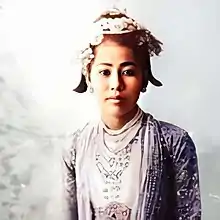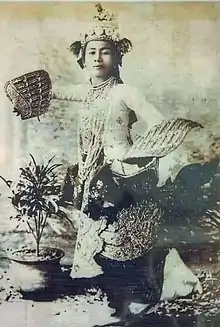Ma Htwe Lay
Ma Htwe Lay (Burmese: မထွေးလေး; pronounced [mɑʔ tʰwé lé]; born Khin Htwe, 1867 – 1927) was a Burmese dancer in the tradition of Sin Kho Ma Lay and Yindaw Ma Lay. She is held up as an ideal in the modern Burmese anyeint industry, and is said to be the mother of Mandalay's second dramatic arts era.[1]
Ma Htwe Lay | |
|---|---|
 Ma Htwe Lay | |
| Born | Khin Htwe 1867 O-toke Kone village, Kyaukse, Burma |
| Died | 1927 (aged 60) |
| Nationality | Burmese |
| Occupation | Burmese traditional dancer |
| Years active | 1879–1927 |
| Spouse(s) | Maung Maung Toke • Phoe Kun • Eikin Mg Gyi • Kyar Nyo |
| Dances | Kinnari • Marionette-style |
Early life
Ma Htwe Lay was born in 1867 in the village of O-toke Kone, Kyaukse, to Min Thiha, the Prince of Khasi and a grandson of Bodawpaya, and his consort Ma Ma Gyi.[2] Although her given name was Khin Htwe, she was called Htwe Lay by Hsinbyumashin, Supayagyi and Supayalat, and that was the name she became generally known by.[3]
Career

She developed an interest in performing and began to learn traditional dancing at the age of 12, with her father's permission. She married Maung Maung Toke, the Prince of Yanaung, when she was 14 years old, and became a pupil of Sin Kho Ma Lay. She also studied both dancing and singing under Yindaw Ma Lay.[2]
As she was not able to read or write, she was instructed in dictation by her mentors. She specialized in Kinnari and marionette-style dancing,[4] and her Burmese anyeint singing was known for its tremulous musical flourishes (မေးရိုက်မေးဝဲ).
In 1886, Ma Htwe Lay married performer Phoe Kun. Her husband introduced her to Manusadda Shwedaung Saya Pu, from whom she learned more traditional dance techniques.[5] Widowed once again a few years later, she married Eikin Mg Gyi and danced with him throughout Burma. When he died after fifteen years of marriage, she married U Kyar Nyo, who was chief of the village of Zeegan Taungbyone, Inwa.[6]
Ma Htwe Lay's most famous role was as Pațācārī in the opera Ma Pațā and Mg Dāsa. Her performance of Patācārī descending into madness after the death of her parents, brother, husband, and children was very well known.[2] Another popular performance was in Sudhanu Manoharī, particularly the scene of Manoharī Kinnari's return to Ngwedaung.
The transition from ground to stage performances was initiated by Ma Htwe Lay and her husband Phoe Kun. Most newcomers to anyeint in the British colonial era were her pupils, including Awba Thaung and Aung Bala.[7] She died in 1927.[8]
Donations
As meritorious deeds for her husband Eikin Mg Gyi, Ma Htwe Lay donated a building to Thitseint Sayadaw and funded the construction of a pagoda in the compound of Mahākhemikārāma Thitseint monastery, at the foot of Mandalay hill.
References
- "သတင်းကြီးသည့်မင်းသမီးမထွေးလေး အတ္ထုပ္ပတ္တိ". mdep.moe.edu.mm.
- "မန္တလေးသဘင်ရဲ့ အကမိခင် မင်းသမီး မထွေးလေး". BBC News မြန်မာ (in Burmese).
- Mranʻ māʹ cvayʻ cuṃ kyamʻʺ: (tū (in Burmese). Mranʻ mā nuiṅʻ ṅaṃ bhā sā pranʻ cā pe ʼa taṅʻʺ. 1954.
- Mranʻ māʹ cvayʻ cuṃ kyamʻʺ (in Burmese). Mranʻ mā Nuinʻ Naṃ Bhā Sā Pranʻ cā Pe ʹA Sāṅʻʺ. 1954.
- ညင်း, စောမုံ (1976). ဗမာအမျိုးသမီး (in Burmese). ပိတောက်လှိုင်းစာပေ.
- "တံတားဦး မြင်းဝန်သုဿန်ရှိ အငြိမ့်မင်းသမီးကြီး မထွေးလေး အုတ်ဂူ၊ နွားကျော်ထသုဿန်သို့ ရွေ့မည်". ဧရာဝတီ. 6 January 2019.
- Chit (Daw), Khin Myo (1969). The 13-carat Diamond and Other Short Stories: a Collection of Short Stories and Sketches. Sarpay Lawka.
- "မင်းသမီးကြီး မထွေးလေး၏ အုတ်ဂူကို သုသာန်အသစ်သို့ ပြောင်းရွှေ့ထိန်းသိမ်းမည်". 7Day News - ၇ ရက်နေ့စဉ် သတင်း.